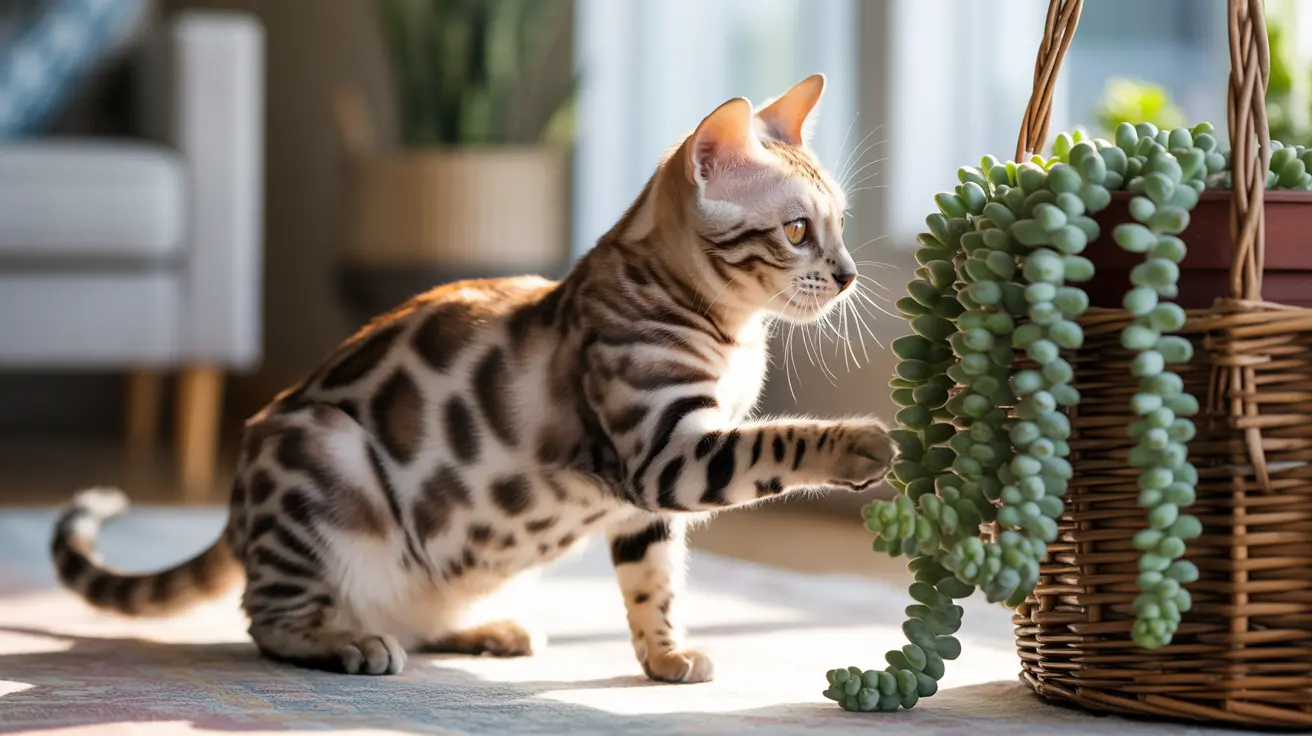Understanding String of Pearls and Its Dangers
String of Pearls (Senecio rowleyanus) is a striking succulent known for its distinctive bead-like leaves that cascade beautifully from hanging baskets. While this decorative plant adds charm to any space, it poses significant health risks to our feline companions. As a responsible cat owner, understanding these risks is crucial for maintaining your pet's safety.
This popular houseplant, despite its innocent appearance, contains toxic compounds that can cause serious health issues in cats. Whether your cat nibbles on the leaves or comes into contact with the plant's sap, the consequences can range from mild discomfort to severe illness.
Toxic Effects and Symptoms
When cats interact with String of Pearls, they may experience various concerning symptoms. The plant's toxicity primarily affects the digestive system and can cause:
- Excessive drooling
- Vomiting
- Diarrhea
- Lethargy
- Loss of appetite
- Abdominal pain
In more severe cases, cats may show signs of:
- Depression
- Weakness
- Behavioral changes
- Difficulty walking
- Dehydration
Immediate Action Steps
If you suspect your cat has ingested any part of the String of Pearls plant, immediate action is crucial:
- Remove any plant material from your cat's mouth if possible
- Document when the exposure occurred
- Collect any vomited material or chewed plant parts
- Contact your veterinarian immediately
- Keep the ASPCA Animal Poison Control number (888-426-4435) handy
Prevention and Safe Alternatives
The best way to protect your cat is through prevention. Consider these safety measures:
- Remove String of Pearls plants from your home entirely
- Place any toxic plants in completely inaccessible areas
- Consider pet-safe alternatives like:
- Spider plants
- Boston ferns
- African violets
- Calathea
- Peperomia
Treatment and Recovery
Veterinary treatment for String of Pearls poisoning typically involves:
- Decontamination procedures
- Fluid therapy to prevent dehydration
- Medication to control vomiting and nausea
- Supportive care and monitoring
- Follow-up appointments to ensure complete recovery
Frequently Asked Questions
Is the String of Pearls plant toxic to cats and what symptoms should I watch for?
Yes, String of Pearls is toxic to cats. Watch for symptoms including excessive drooling, vomiting, diarrhea, lethargy, and loss of appetite. These symptoms typically appear within a few hours of ingestion.
What should I do if my cat ingests the String of Pearls succulent?
Immediately contact your veterinarian or the ASPCA Animal Poison Control Center. Remove any remaining plant material from your cat's reach and monitor their symptoms. Don't attempt to induce vomiting without professional guidance.
Can touching the String of Pearls plant cause irritation to my cat's skin?
Yes, the sap from String of Pearls can cause skin irritation in cats. If your cat comes into contact with the plant, you may notice redness, itching, or inflammation of the affected area.
How can I keep my cat safe from toxic succulents like the String of Pearls at home?
The safest approach is to remove String of Pearls and other toxic succulents from your home. If you must keep them, ensure they're in completely inaccessible areas like closed rooms or high-mounted hanging baskets.
Are there any safe cat-friendly succulent alternatives to the String of Pearls plant?
Yes, several cat-safe succulents include Haworthia, Echeveria, and Christmas cactus. Always verify plant safety through the ASPCA toxic plants database before bringing new plants into your home.
Conclusion
While String of Pearls is undoubtedly beautiful, its toxicity to cats makes it a risky choice for cat-owning households. By understanding these risks and taking appropriate precautions, you can create a safer environment for your feline friend. When in doubt, always choose pet-safe alternatives and keep emergency contact numbers readily available.






